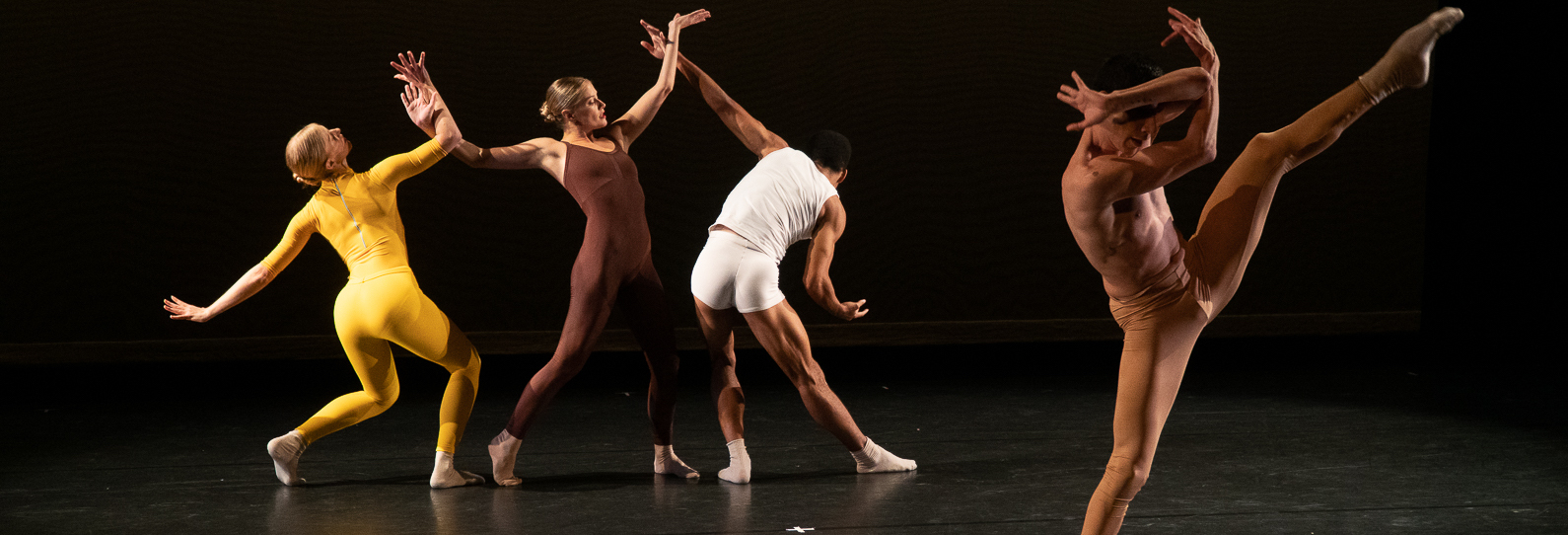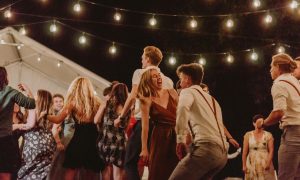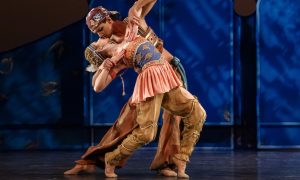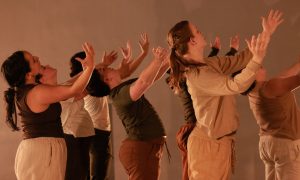Woodman Family and Community Arts Center, Providence, RI.
October 23, 2022.
Have you ever looked at a painting and felt like its living figures could be alive, like they could leap out into your space and move before your eyes? Or perhaps like the painting inspired you to move or take action in some way? Festival Ballet Providence drew upon this connection of two-dimensional visual art and three-dimensional moving art for its 2022-2023 Season Opener Off the Wall. The result was true aesthetic confluence: two art forms coming together to create something cohesive, memorable and thought-provoking.
The program was produced in collaboration with the RISD Museum, of the Rhode Island School of Design (Providence, RI), where the paintings inspiring its works are on exhibit. As is the norm with Festival Ballet Providence programming, a short documentary-style video preceded each piece (except the first, a classical work from Festival Ballet Providence’s repertoire), bringing additional audience understanding through the context of artists’ perspectives, while also leaving room for audience members to explore their own interpretations. All three of these painting-inspired works were world premieres.
To honor the classics, as Festival Ballet Providence always aims to do to some degree in its programming, the program kicked off with a reprise of Pas de Quarte. I enjoyed the work in February of this year, chamber performance-style (in Festival Ballet Providence’s black box theater) versus in a larger proscenium setting (à la a Degas painting with patrons watching the performance but also each other). If in slightly different contexts of the past at hand, at both points I was transported back into that past – thanks to the dancers’ skillful and soulful investment as well as staging by the company just as skillful and invested.
The first work in the program in dialogue with works at the RISD Museum was Yusha-Marie Sorzano’s Two Women, a thoughtful work also full of aesthetic wonder. In the video introduction, Sorzano described how Rufino Tamayo’s painting of the same name (1939) inspired her. The painting’s figures and shapes are abstract, yet visually crisp. Even with similarly clear colors, those characterizing these shapes and figures, a dimness to the coloring (rather than colors that pop) offer something calming and easeful – if also procuring mystery and reflectiveness.
Representing two women of color, in a decolonized context, the painting drew Sorzano to lift up voices and stories like those of these women. As an artist of color, she described a choice that she faces: of lifting up such voices through a still-Westernized lens, or instead bringing in a whole new lens through which to illuminate marginalized and forgotten experiences. In conversation with this painting, it seems like she found a way to do the latter: with grace, skill, and courage.
The work opened on two women: moving in unison to start, then finding their own kinetic possibilities. Their long earthy-yellow dresses – through the movement of fabric and the shadows they created in the dim lighting (by Alicia Colantonio) – expanded the movement at hand, both of tangible shape and of light and pure energy through space. The vibrancy of their movement, expansive and fearless, met the ebullience of the score – a sole woman singing poignantly and passionately.
Within that keen musicality, these dancers found both clear accent and undulating flow of momentum. They fueled these qualities with intentional breath, with both strength and release. Overall, Sorzano’s movement vocabulary struck me as particularly intentional and somatically attuned – overall, just a treat to take in. As lovely as these dancers were and this movement was, if the whole piece stayed as just them, that might have come off as just a bit literal and facile – as a quite direct translation of the painting into movement.
Yet, it didn’t stay as such; soon, a whole ensemble of women wearing those same dresses entered and multiplied the energetic, kinetic èlan at hand even further. Danseurs, wearing all black, were part of this expanded ensemble. They partnered and lifted ballerinas, bringing the compelling gesture and shaping into a higher plane of space – giving it more dimension.
I did wonder if such an effect might have been possible with the ballerinas partnering each other (I’ve seen enough of that lately, in varied programs, to believe that we women can do it – within certain bounds – quite safely and effectively). I wondered if and how the atmosphere might have felt different if the piece stayed entirely female. Yet I didn’t think about that too much, because I was simply enthralled with the movement’s vim and verve, smoothly shifting formations, and the fresh overall aesthetic of the work I was experiencing.
In a particularly striking moment later on in the work, some dancers stood still and gazed towards other dancers moving: witnessing. As the piece slowly softened in energy and went full-circle – ending with two women, as it began – I thought about that witnessing. In bringing us an all-too-little heard story in movement, in raising the voices of those all-too-often unseen, Sorzano allowed us in the audience to also witness.
Festival Ballet Providence Artistic Curator Yury Yanowsky’s Jackie came third in the program, a work with Yanowsky’s signature classically-foundationed, yet strikingly innovative aesthetic. Eugene Feldman’s Friend’s Wife’s Profile (1964) inspired the work, a postmodern two-dimensional interpretation of Jackie Kennedy. In the painting, slightly splotchy dots of flesh-tone offset dark to create Mrs. Kennedy’s profile. Powerfully, with the rest of the painting dark, it almost feels as if that dark is closing in on her.
In the video introduction, Yanowsky described how he felt personally moved by the painting, seeing “the demons [that] she had to fight” while in the gaze of the entire nation – all of the “light and dark,” so much complexity, in one person. Movement did just justice to this clarity of concept; from the very start, it was was strong, lifted but connected to its grounded foundation: full of the fortitude and resolve evident in Jackie Kennedy’s character.
Such dynamic contrasts aligned with the “light and dark” that Yanowsky described, that inspired him – as well as the light and dark in Feldman’s painting. Combined with its physical strength, a high level of circularity in the movement vocabulary also evoked the freneticism and relentlessness of life in the public eye – the kind that Jackie Kennedy experienced (while grieving, to boot).
Turns with lifts from underneath the arms – arms spread wide like an appreciable wingspan – spoke to support through that experience. Frequent giving and taking of weight evoked a fluid mutuality of such support. Also memorable to me was the keen musicality in a solo moving into a duet, finding harmony with Marta Sebestyén // Henryk Górecki’s layered, mysterious score. The movement rode waves of momentum as well as layers in the score.
Design was also memorable; the painting remained on the backdrop for some time, then faded to black. It came back later in the work, in a vibrant ensemble section – before it all truly came full circle with a duet, as it started. The circularity in the movement and structure: Jackie Kennedy’s struggles were unique, yet in some ways timeless. We all grieve, fight our own demons, balance what we need and how we are seen. Yanowosky cogently investigated those truths in movement, from the inspiration of a keen painting: true aesthetic confluence.
Closing out the program was Andrea Schermoly’s Gather – a sweet and lighthearted embodiment of Bridget Riley’s line and color-based painting of the same name (1981). Vertical lines of color, in a long string and from aqua to magenta, pop off the canvas (and from each other – they certainly don’t blend). In the video introduction to Schermoly’s work, she described loving Riley’s “ideas and brain”: how her abstraction does speak to human emotion. Short of explicit narrative, the dancers in the work nevertheless imbued their full humanity with how they moved through space and through Riley’s movement vocabulary – as fully independent individuals, together.
First to catch my eye as the lights came up was the moving backdrop: an animation of the painting, with vertical lines of wide-ranging colors continuously scrolling sideways. Entranced by the effect, I thought about how with color and line-based postmodern art, what’s most special is perhaps not what’s on the canvas but the feeling of harmony that the work can evoke in the viewer.
From a horizontal line at upstage, dancers – each wearing their own color of unitard – came forward to dance a short solo. In short duet moments of one soloist finishing and another beginning, they passed off the proverbial baton. Later, they danced as an ensemble. Looking at art, we can be drawn to individual elements or the totality of the image. In the pure authentic joy with which they danced, the ensemble also offered something as unique and unconventional as the painting. Normal is overrated, I thought to myself and smiled.
Apart from effective embodiment of the painting, the dancers also brought the vibrant, almost whimsical scores to kinetic form. That even came through sweet moments like the ensemble tik-toking their hips back and forth in rhythmic unison. Watching this and just feeling delighted, I would defy anyone to say such a fun and human moment doesn’t fit in with concert ballet! The feeling evoked is just as important as what’s in front of us, I remembered.
Schermoly’s choreography included just as much classical influence, however – such as turning lifts and luscious lines. After all, a painting like Riley’s calls for classical principles and virtuosity as much as it does daring to create something totally one’s own. Embrace, yet then release – just as duet partners did at one point (a beautiful idea in movement which had my mind buzzing with possibility!). With aesthetic forms in conversation, just as they were in this program, both embrace and release are possible.
The structure of the piece even illustrated that intriguing duality; a largely vivacious piece ended in a softer, more reflective duet. I pondered on how often with taking in visual art, the kind that really resonates, one can at first be struck by aesthetic force and then – over a few absorbed moments – soften into the experience. All of that is just one dynamic among many that Off the Wall explored – dynamics that can emerge in aesthetic confluence, when separate artistic forms meet and merge. Magic can then grow, and grace each individual who encounters it.
By Kathryn Boland of Dance Informa.















